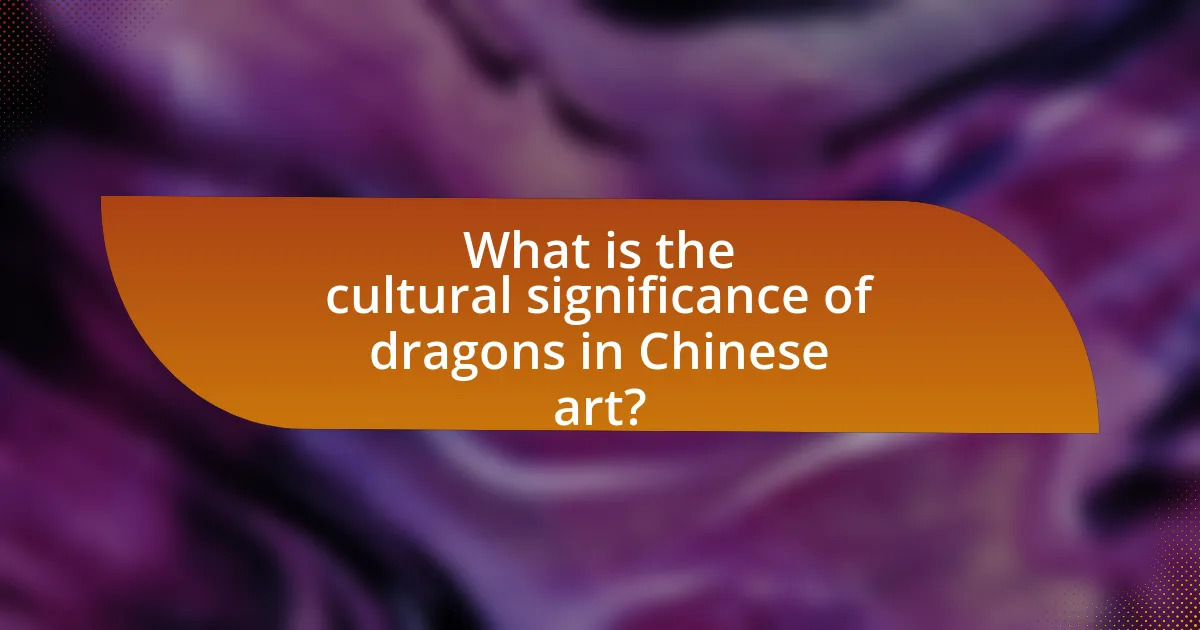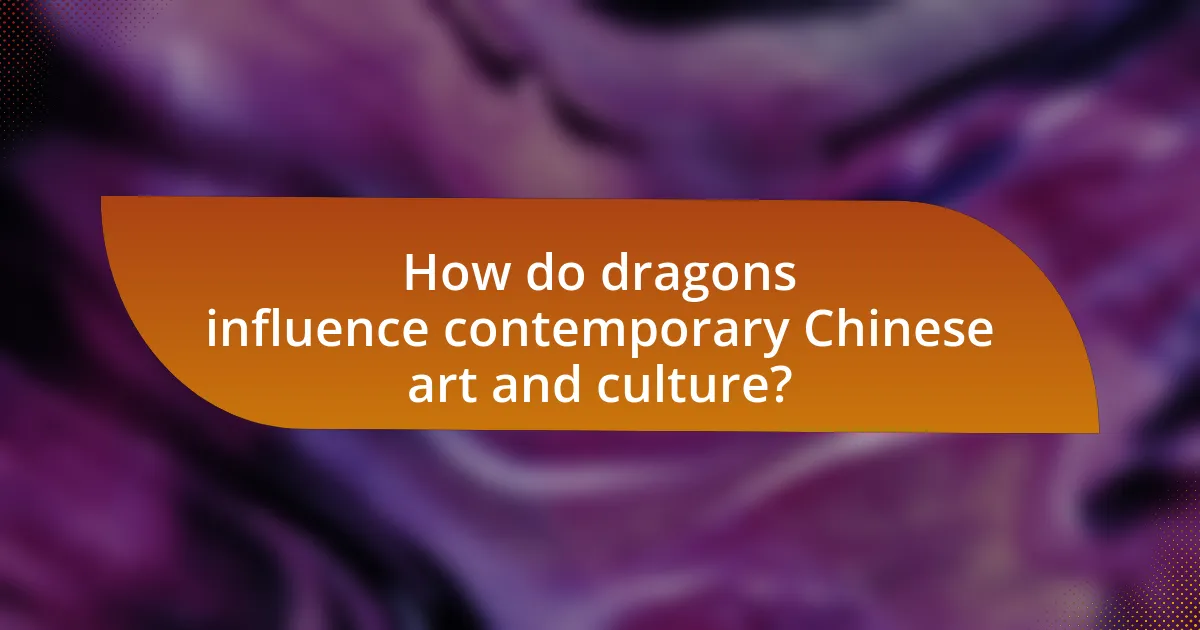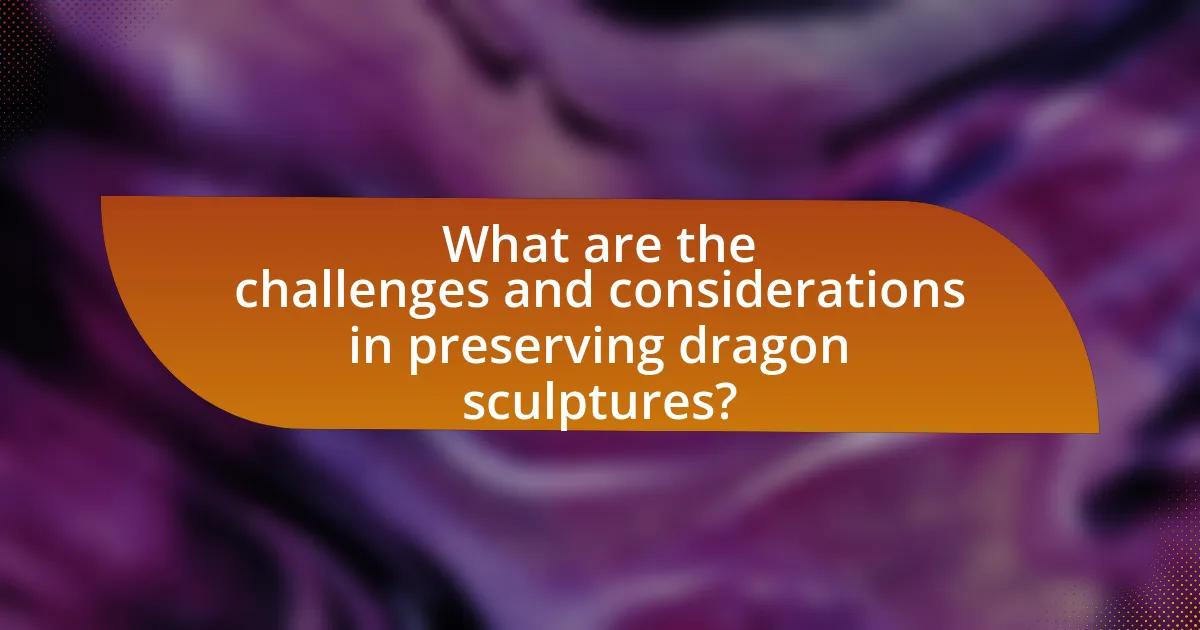Dragons are a significant cultural symbol in Chinese art, representing power, strength, and good fortune. This article explores the historical origins of dragon imagery, its representation across various art forms, and the influence of different dynasties on these depictions. It also examines the role of dragons in contemporary Chinese culture, their impact on festivals, and the challenges faced in preserving dragon sculptures. Additionally, the article highlights modern interpretations of dragon motifs and the importance of community engagement in conservation efforts, providing a comprehensive overview of the dragon’s enduring significance in Chinese heritage.

What is the cultural significance of dragons in Chinese art?
Dragons hold immense cultural significance in Chinese art, symbolizing power, strength, and good fortune. In traditional Chinese culture, dragons are revered as auspicious creatures associated with water, agriculture, and imperial authority. Historically, they were often depicted in art to represent the emperor’s divine right to rule, as seen in imperial robes and architecture adorned with dragon motifs. Additionally, dragons are integral to festivals and celebrations, such as the Dragon Boat Festival, emphasizing their role in cultural identity and heritage. The prevalence of dragons in various art forms, including paintings, sculptures, and ceramics, underscores their enduring importance in conveying cultural values and beliefs within Chinese society.
How have dragons been represented in various forms of Chinese art?
Dragons have been represented in various forms of Chinese art as symbols of power, strength, and good fortune. In traditional Chinese paintings, dragons are often depicted soaring through clouds, emphasizing their connection to the heavens and their role as rain-bringers, which is vital for agriculture. Sculptures, particularly in temples and palaces, showcase dragons intricately carved into stone or wood, often coiling around pillars or adorning roofs, signifying protection and auspiciousness. Additionally, ceramics and textiles feature dragon motifs, where the creature is stylized in vibrant colors, reflecting its importance in Chinese mythology and culture. Historical artifacts, such as the Ming Dynasty’s dragon robes, illustrate the dragon’s association with imperial authority, as only emperors were allowed to wear garments adorned with dragon imagery. These representations collectively highlight the dragon’s multifaceted role in Chinese art as a revered and auspicious figure throughout history.
What are the historical origins of dragon imagery in Chinese culture?
Dragon imagery in Chinese culture originates from ancient Chinese mythology and has evolved over thousands of years. The earliest representations date back to the Neolithic period, around 5000 BCE, where dragon-like figures appeared in pottery and jade carvings. These early depictions were often associated with water and fertility, reflecting the dragon’s role as a rain deity.
By the Shang Dynasty (1600-1046 BCE), dragons became symbols of power and authority, often linked to the emperor, who was considered the “Son of Heaven.” The dragon’s significance continued to grow during the Zhou Dynasty (1046-256 BCE), where it was associated with auspiciousness and protection.
The historical context of dragon imagery is supported by archaeological findings, such as the discovery of dragon motifs in ancient bronze vessels and inscriptions, which highlight the creature’s importance in rituals and governance. Thus, the dragon has transformed from a symbol of nature to a representation of imperial power and cultural identity in Chinese society.
How do different dynasties influence dragon representations in art?
Different dynasties significantly influence dragon representations in art through variations in symbolism, style, and cultural context. For instance, during the Han Dynasty (206 BCE – 220 CE), dragons were often depicted as benevolent creatures associated with water and agriculture, reflecting the agrarian society’s reliance on rain and rivers. In contrast, the Tang Dynasty (618–907 CE) showcased dragons as powerful, imperial symbols, often adorned with intricate designs to signify the emperor’s divine right to rule. The Song Dynasty (960–1279 CE) introduced a more stylized and elegant representation, emphasizing grace and fluidity, which mirrored the era’s artistic advancements. Each dynasty’s unique political, social, and cultural circumstances shaped how dragons were portrayed, making them a dynamic symbol throughout Chinese history.
Why are dragons considered symbols of power and auspiciousness?
Dragons are considered symbols of power and auspiciousness due to their historical association with imperial authority and good fortune in Chinese culture. In ancient China, dragons were believed to control water, rainfall, and floods, making them vital for agriculture and prosperity. This connection to nature and its elements reinforced their status as powerful beings. Additionally, the dragon is often depicted in imperial iconography, representing the emperor’s divine right to rule, further solidifying its association with power. The belief in dragons as harbingers of good luck is also reflected in cultural practices, such as dragon dances during festivals, which are intended to bring prosperity and ward off evil.
What role do dragons play in Chinese mythology and folklore?
Dragons in Chinese mythology and folklore symbolize power, strength, and good fortune. They are revered as benevolent creatures associated with water, agriculture, and the emperor, often depicted as bringers of rain and prosperity. Historical texts, such as the “Shan Hai Jing” (Classic of Mountains and Seas), illustrate dragons as guardians of rivers and seas, emphasizing their role in maintaining harmony in nature. Additionally, dragons are integral to Chinese cultural celebrations, such as the Dragon Boat Festival, which honors their significance in community and agricultural success.
How do dragons embody the concept of yin and yang in Chinese philosophy?
Dragons embody the concept of yin and yang in Chinese philosophy by representing the duality of nature, where they symbolize both the masculine and feminine forces. In this context, dragons are often associated with yang qualities such as strength, power, and activity, while their counterparts, such as phoenixes, embody yin qualities like grace, beauty, and passivity. This duality is reflected in traditional Chinese art and sculpture, where dragons are depicted in dynamic poses, often intertwined with other symbols that represent balance and harmony. The historical significance of dragons in Chinese culture further reinforces this concept, as they are seen as auspicious creatures that bring good fortune and prosperity, embodying the harmonious interplay of opposing forces in the universe.
What are the different types of dragon sculptures found in Chinese art?
Different types of dragon sculptures found in Chinese art include the imperial dragon, the celestial dragon, the earth dragon, and the spiritual dragon. The imperial dragon, characterized by five claws, symbolizes the emperor and imperial authority, while the celestial dragon represents power and protection, often depicted in clouds. The earth dragon is associated with the earth’s elements and agriculture, and the spiritual dragon embodies transformation and spiritual growth. These classifications reflect the cultural significance of dragons in Chinese mythology and art, where each type serves a distinct symbolic purpose, reinforcing their importance in Chinese heritage.
What materials are commonly used in dragon sculptures?
Dragon sculptures are commonly made from materials such as stone, wood, metal, and ceramics. Stone, including jade and marble, is often used for its durability and aesthetic appeal, while wood allows for intricate carvings and detailed designs. Metal, particularly bronze, is favored for its strength and ability to capture fine details, and ceramics are utilized for their versatility and vibrant glazes. These materials have been historically significant in Chinese art, reflecting cultural values and artistic traditions associated with dragons.
How do regional styles affect the design of dragon sculptures?
Regional styles significantly influence the design of dragon sculptures by incorporating local artistic traditions, materials, and cultural symbolism. For instance, in southern China, dragon sculptures often feature a more elongated body and intricate detailing, reflecting the region’s emphasis on fluidity and grace in art. In contrast, northern styles may present dragons with a stockier build and more robust features, aligning with the harsher climate and cultural values of strength and resilience. Additionally, the use of specific materials, such as jade in southern sculptures and stone in northern designs, further distinguishes regional characteristics. Historical records indicate that these variations not only represent aesthetic preferences but also embody the spiritual and cultural significance attributed to dragons in different locales, reinforcing their role as symbols of power and protection.

How do dragons influence contemporary Chinese art and culture?
Dragons significantly influence contemporary Chinese art and culture by symbolizing power, strength, and good fortune. In modern artistic expressions, dragons are frequently depicted in various forms, including paintings, sculptures, and textiles, reflecting their deep-rooted cultural significance. For instance, the dragon motif is prevalent in festivals, such as the Chinese New Year, where dragon dances are performed to bring prosperity and ward off evil spirits. Additionally, contemporary artists often reinterpret traditional dragon imagery, merging it with modern techniques and themes, thereby preserving cultural heritage while appealing to global audiences. This ongoing integration of dragons into contemporary art underscores their enduring relevance in Chinese identity and cultural narratives.
What modern interpretations of dragons exist in today’s art scene?
Modern interpretations of dragons in today’s art scene often blend traditional symbolism with contemporary aesthetics, showcasing dragons as symbols of power, wisdom, and cultural identity. Artists utilize various mediums, including digital art, sculpture, and street art, to reinterpret dragons, reflecting both Eastern and Western influences. For instance, contemporary Chinese artists like Xu Bing incorporate dragons into installations that explore themes of globalization and cultural heritage, while street artists like KAWS reimagine dragon imagery in playful, cartoonish styles. These interpretations highlight the adaptability of dragon motifs in addressing modern societal issues and personal narratives, demonstrating their enduring relevance in contemporary art.
How do contemporary artists incorporate traditional dragon motifs?
Contemporary artists incorporate traditional dragon motifs by blending them with modern techniques and materials, creating a dialogue between historical significance and contemporary aesthetics. For instance, artists like Ai Weiwei utilize dragon imagery in installations that comment on cultural identity and political issues, thereby recontextualizing the dragon as a symbol of power and resilience in today’s society. Additionally, many artists employ mixed media, such as digital art and sculpture, to reinterpret the dragon’s form, often integrating elements of traditional Chinese art with contemporary styles, which reflects the ongoing relevance of dragons in cultural narratives.
What impact do dragons have on popular culture in China today?
Dragons significantly influence popular culture in China today by symbolizing power, strength, and good fortune. In contemporary media, dragons appear in films, television shows, and literature, often representing heroic qualities and cultural heritage. For instance, the dragon is a central figure in the Chinese New Year celebrations, where dragon dances are performed to bring prosperity and ward off evil spirits. Additionally, the dragon motif is prevalent in fashion, art, and design, reflecting its status as a national symbol. This cultural prominence is supported by historical significance, as dragons have been revered in Chinese mythology for thousands of years, reinforcing their role in modern identity and cultural expression.
Why are dragons still relevant in modern Chinese society?
Dragons remain relevant in modern Chinese society due to their deep-rooted symbolism as embodiments of power, strength, and good fortune. In contemporary culture, dragons are prominently featured in festivals, art, and architecture, reflecting their historical significance as auspicious creatures. For instance, the dragon dance is a traditional performance during celebrations like the Lunar New Year, symbolizing the ushering in of prosperity and happiness. Additionally, dragons are often depicted in modern Chinese art and design, reinforcing their status as national symbols and cultural icons. This ongoing representation in various forms of expression highlights the dragon’s enduring influence and relevance in the collective identity of Chinese society.
How do dragons symbolize national identity and pride in China?
Dragons symbolize national identity and pride in China by representing strength, power, and auspiciousness. In Chinese culture, the dragon is viewed as a benevolent creature that brings good fortune and is associated with the emperor, reinforcing its status as a symbol of authority and unity. Historically, the dragon has been linked to the concept of the “Son of Heaven,” where emperors were considered descendants of dragons, thus intertwining the creature with national identity. The dragon is also prominently featured in festivals, art, and architecture, such as the dragon motifs in the Forbidden City, which further solidify its role as a national emblem.
What role do dragons play in festivals and celebrations in contemporary China?
Dragons play a central role in festivals and celebrations in contemporary China, symbolizing power, strength, and good fortune. During events such as the Lunar New Year and the Dragon Boat Festival, dragon dances are performed to invoke blessings and drive away evil spirits. These performances often feature elaborate dragon costumes and are accompanied by music and drums, creating a vibrant atmosphere. The significance of dragons is rooted in Chinese mythology, where they are revered as auspicious creatures that bring prosperity and harmony. This cultural reverence is reflected in the widespread use of dragon imagery in decorations and art during these celebrations, reinforcing their importance in Chinese heritage.

What are the challenges and considerations in preserving dragon sculptures?
Preserving dragon sculptures presents challenges such as environmental degradation, material deterioration, and cultural significance. Environmental factors like humidity, temperature fluctuations, and pollution can lead to the erosion of materials used in these sculptures, often made from stone, wood, or metal. Additionally, the chemical reactions between pollutants and the sculpture materials can accelerate decay.
Material deterioration is a significant concern, as many dragon sculptures are ancient and may have already suffered from wear over time. For instance, sculptures made of wood are particularly vulnerable to pests and moisture, while stone sculptures can be affected by acid rain.
Cultural significance also plays a crucial role in preservation efforts, as dragon sculptures often embody deep-rooted beliefs and traditions. Ensuring that restoration methods respect the original artistic intent and cultural context is essential. This requires collaboration with cultural historians and conservation experts to maintain authenticity while addressing physical damage.
How do environmental factors affect the preservation of dragon sculptures?
Environmental factors significantly affect the preservation of dragon sculptures by influencing their material integrity and exposure to deterioration agents. For instance, humidity can lead to corrosion in metal sculptures, while extreme temperatures can cause cracking in stone or ceramic materials. Additionally, pollutants in the air, such as sulfur dioxide, can accelerate the weathering process, particularly in urban environments. Studies have shown that sculptures exposed to high levels of moisture and pollutants experience a higher rate of degradation, necessitating more frequent conservation efforts. Therefore, the preservation of dragon sculptures is closely tied to the environmental conditions surrounding them, which can either enhance or hinder their longevity.
What techniques are used to restore and maintain dragon sculptures?
Techniques used to restore and maintain dragon sculptures include cleaning, structural reinforcement, and surface treatment. Cleaning involves the careful removal of dirt and pollutants using soft brushes and specialized solvents to prevent damage to the sculpture’s surface. Structural reinforcement may involve the use of adhesives or supports to stabilize any weakened areas, ensuring the integrity of the sculpture. Surface treatment can include applying protective coatings to shield against environmental factors such as moisture and UV light, which can cause deterioration over time. These methods are essential for preserving the artistic and cultural significance of dragon sculptures in Chinese art.
How can cultural heritage organizations contribute to the preservation of dragon art?
Cultural heritage organizations can contribute to the preservation of dragon art by implementing conservation programs, conducting research, and promoting public awareness. These organizations often possess the expertise and resources necessary to restore and maintain dragon sculptures, which are significant in Chinese culture, representing power and good fortune. For instance, the Palace Museum in Beijing has undertaken extensive restoration projects for dragon motifs found in imperial artifacts, ensuring their longevity and cultural relevance. Additionally, these organizations can facilitate educational initiatives that highlight the historical significance of dragon art, thereby fostering appreciation and support for its preservation among the public.
What best practices should be followed for the conservation of dragon sculptures?
The best practices for the conservation of dragon sculptures include regular cleaning, controlled environmental conditions, and appropriate restoration techniques. Regular cleaning prevents the accumulation of dust and pollutants that can damage the surface, while controlled environmental conditions, such as stable temperature and humidity, help to minimize deterioration. Appropriate restoration techniques, such as using reversible materials and methods, ensure that any repairs do not compromise the original integrity of the sculpture. These practices are supported by conservation standards established by organizations like the International Institute for Conservation, which emphasize the importance of maintaining the original materials and craftsmanship in cultural artifacts.
How can communities engage in the preservation of their local dragon art?
Communities can engage in the preservation of their local dragon art by organizing collaborative restoration projects and educational programs. These initiatives can involve local artists, historians, and community members to ensure that the techniques and cultural significance of dragon art are passed down through generations. For instance, community workshops can teach traditional sculpting methods, while public exhibitions can raise awareness about the historical context and importance of dragon art in local culture. Additionally, partnerships with cultural organizations can provide resources and funding for preservation efforts, ensuring that these artistic expressions remain vibrant and relevant.
What resources are available for learning about dragon sculpture conservation?
Resources for learning about dragon sculpture conservation include academic journals, online courses, and specialized workshops. Notable journals such as “Studies in Conservation” and “The Journal of the American Institute for Conservation” publish peer-reviewed articles on conservation techniques and case studies relevant to dragon sculptures. Online platforms like Coursera and edX offer courses on art conservation that cover materials and methods applicable to dragon sculptures. Additionally, institutions like the Getty Conservation Institute provide workshops and resources focused on sculpture conservation, including specific techniques for handling and preserving cultural artifacts like dragon sculptures.


